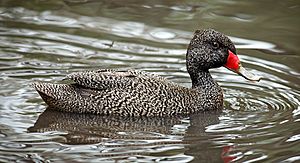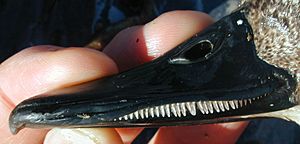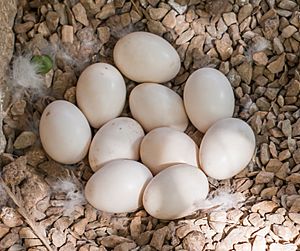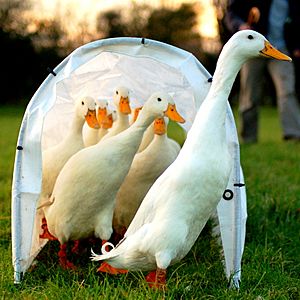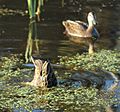Duck facts for kids
Quick facts for kids Ducks |
|
|---|---|
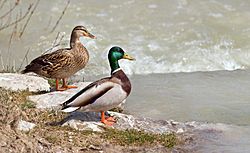 |
|
| The brown bird on the left is the female; the brightly colored one on the right is the male, called a drake. This is the most common duck in the world, the Mallard (Anas platyrhynchos) | |
| Scientific classification | |
| Kingdom: | |
| Phylum: | |
| Class: | |
| Order: | |
| Family: | |
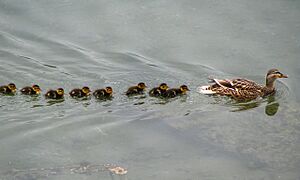
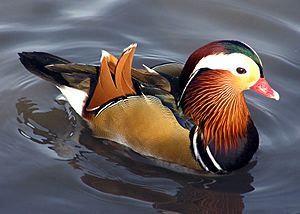
Ducks are birds that belong to the family Anatidae. They are related to swans and geese, which are in the same family. Ducks are usually smaller than swans and geese and have shorter necks.
Other birds that swim and dive, like grebes and loons, might look like ducks but are not. A baby duck is called a duckling, and a male duck is called a drake. Most ducks are aquatic birds. This means they live in or near water. You can find them in both saltwater and fresh water.
Ducks lay eggs once a year. They are omnivores, meaning they eat both plants and animals. They enjoy aquatic plants and tiny animals. Some ducks, called dabbling ducks, find food on the water's surface or on land. They might also tip upside down in the water to reach food without fully diving. Their beak has a comb-like part called a pecten. This helps them filter food from the water. It also helps them clean their feathers. Diving ducks go deep underwater to find their meals.
Many ducks are migratory. This means they travel to different places for summer and winter. Ducks live almost everywhere in the world, except for Antarctica. Some duck species even live on very cold islands near Antarctica, like South Georgia and the Auckland Islands. Many kinds of ducks have also made homes on faraway islands, such as Kerguelen or Hawaii.
Some ducks are raised by humans. These are not wild ducks. People keep them for food (like meat and eggs) or for their feathers. Duck feathers are used in things like pillows. Eating duck is very popular, especially in Asia.
Ducks are sometimes kept as pets. People often keep them on public ponds because they are beautiful and peaceful. Many people like to feed ducks stale bread at ponds. However, bread is not good for ducks and can make them sick or even kill them. It's much better to feed them special duck food or small pieces of corn or oats.
Contents
Duck Behaviour

How Ducks Find Food
Ducks eat many different things. They munch on grasses, water plants, fish, insects, small amphibians, worms, and tiny molluscs.
Dabbling ducks feed on the water's surface or on land. They can also tip their bodies into the water to reach food without fully diving. The comb-like pecten on their beak filters food from the water. It also helps them clean their feathers and hold slippery food.
Diving ducks and sea ducks dive deep underwater to find food. Diving ducks are heavier than dabbling ducks. This helps them dive easily, but it also makes it harder for them to take off and fly.
Some special ducks, like mergansers, are made to catch and swallow large fish. Other ducks have wide, flat beaks. These beaks are great for digging in mud to find worms or insect larvae. They can also pull up water plants. Their nostrils are protected by hard horn, so they don't get hurt when digging.
Remember, it's not good to feed ducks bread. It can harm their health and pollute the water.
How Ducks Have Families

Ducks usually stay with one partner, but often only for one year. Larger ducks or those that stay in one place might stay with the same partner for several years. Most ducks have babies once a year, usually in spring or summer, or during wet seasons. Ducks build a nest before laying eggs. After the ducklings hatch, the mother leads them to water. Mother ducks are very caring and protect their young. However, they might leave some ducklings if they are stuck or not healthy. Ducklings can also be left alone if they hatch much later than their siblings.
Most domestic ducks don't sit on their eggs or care for their ducklings. Their eggs often need to be hatched by a broody hen or in an incubator.
How Ducks Talk
Female mallard ducks make the famous "quack" sound. Male mallards make a rougher sound, sometimes like "breeeeze." But most other duck species do not "quack." Ducks make many different calls, like whistles, cooing, yodels, and grunts. For example, the scaup duck makes a sound like "scaup," which is how it got its name! Their calls can be loud for showing off or quieter for staying in touch.
There's a common story that a duck's quack doesn't echo. But this is not true! Scientists proved this myth wrong in 2003. It was also shown to be false on the TV show MythBusters.
Where Ducks Live
Ducks live all over the world. Some species live on very cold islands like South Georgia and the Auckland Islands. Many ducks have also made homes on islands in the ocean, such as Hawaii, New Zealand, and Kerguelen. However, some of these island ducks are now in danger or have disappeared.
Some ducks, especially those that breed in cooler northern areas, travel long distances. This is called migration. Ducks in warmer, tropical places usually don't migrate. Some ducks, especially in Australia where rain is not always regular, are nomadic. They move around to find temporary lakes and pools that appear after heavy rain.
Who Hunts Ducks
Ducks have many animals that hunt them. Ducklings are especially easy targets because they can't fly. They can be caught by big fish like pike, crocodilians, large turtles like the Alligator snapping turtle, and other water hunters like herons. Duck nests can be raided by animals on land, such as foxes. Mother ducks sitting on their nests can also be caught by mammals or large birds like hawks or owls.
Adult ducks can fly very fast. In the air, they are safe from most predators, except for humans and the peregrine falcon. The peregrine falcon is very fast and strong and often catches ducks. In the water, adult ducks can be caught by large fish like the North American muskie and the European pike.
Ducks and Humans
Hunting Ducks
Humans have hunted ducks for a very long time. People in ancient times used ducks for food. They would catch many ducks, especially when they were migrating. People in different parts of the world, from the Caribbean to China, relied on ducks for food. Some flightless duck species were hunted so much that they may have become extinct.
Today, wild ducks are still hunted for food or for sport. Hunters often use special calls or decoys to attract ducks. The phrase "a sitting duck" means an easy target. This comes from how easy it is to catch a duck that is floating still or sitting on land.
Ducks as Farm Animals
Ducks are very useful animals for people. They are raised on farms for their meat, eggs, and feathers. Their soft down is especially valued. About 3 billion ducks are raised for meat each year around the world. Ducks are also kept by bird lovers and shown in zoos. Most types of farm ducks come from the wild mallard (Anas platyrhynchos). The Muscovy duck (Cairina moschata) is another type of domestic duck. The Call duck is a small domestic duck breed. Hunters used them as decoys to attract wild mallards. Call ducks weigh less than 1 kilogram (2.2 pounds).
Ducks in Symbols

Ducks appear on some coats of arms, which are special symbols for towns or families. For example, ducks are on the coat of arms of Lubāna in Latvia and Föglö in Åland.
Cool Facts About Ducks
- The word "duck" means to "bend down low" or "dive". Ducks are named this because they often duck under the water to find food.
- Duck feathers are so waterproof that even if they dive deep, the soft feathers underneath stay dry.
- Ducks are curious and like interesting things, like shiny objects and mirrors.
- Owls are predators that hunt ducks.
- Ducks sleep on river banks or on the water. Some kinds of ducks even sleep in trees. They sleep with their head tucked on their back, between their feathers.
- A male duck is called a drake. A female is simply called a duck.
- Ducks are thought to be smarter than chickens.
- When there is more daylight, ducks tend to lay more eggs.
- Ducklings grow very fast! They are often ready to fly by the time they are just two months old.
- Ducks can live for up to 20 years.
Related pages
Images for kids
-
Pacific black duck showing how it "ducks" for food
-
Mallard landing
-
Flying steamer ducks in Ushuaia, Argentina
See also
 In Spanish: Pato para niños
In Spanish: Pato para niños


